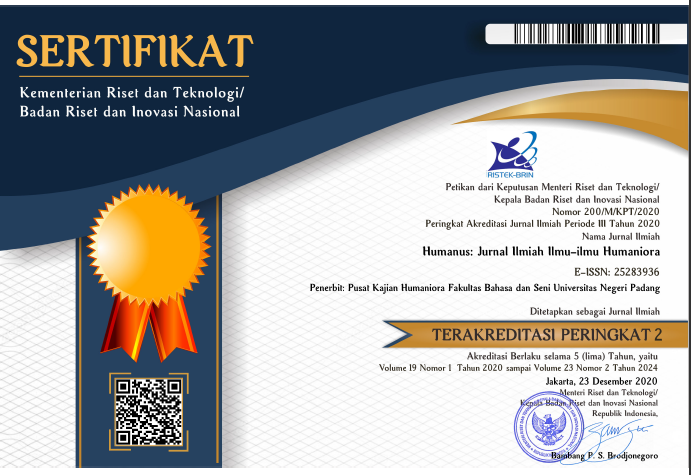GENDER EQUALITY AND WOMEN’S POWER IN AMERICAN INDIAN TRADITIONAL CULTURE IN ZITKALA-SA'S SHORT STORIES
 ),
), (1) Universitas Negeri Manado
 Corresponding Author
Corresponding Author
Copyright (c) 2018 Humanus
DOI : https://doi.org/10.24036/humanus.v17i2.100625
Full Text:
 Language : en
Language : en
Abstract
This article intends to reveal gender equality and women’s power in American Indian traditional culture before they were assimilated in white American society in the late nineteenth century as reflected in Zitkala-Sa’s short stories, Impressions of an Indian Childhood, The Soft Hearted Sioux and A Warrior Daughter. This study is a qualitative research that applies feminist literary approach which uses liberal feminist theory for the data analysis. This study shows that American Indian women enjoyed gender equality in traditional American Indian culture that had complementary gender relation. American Indian women had power and equal rights to be warriors and leaders in their society.
Keywords: gender role, American Indian women, complimentary relation.
KESETARAAN GENDER DAN KUASA PEREMPUAN DALAM BUDAYA TRADISIONAL INDIAN AMERIKA DALAM CERITA-CERITA PENDEK ZITKALA-SA
Abstrak
Artikel ini bertujuan untuk mengungkapkan kesetaraan gender dan kuasa perempuan Indian Amerika dalam budaya tradisional masyarakat Indian Amerika sebelum mereka mengalami program asimilasi yang bertujuan untuk menyatukan masyarakat Indian Amerika dengan masyarakat kulit putih di akhir abad ke-19 seperti yang terefleksi dalam cerita pendek Zitkala-Sa, Impressions of an Indian Childhood,The Soft Hearted Sioux dan A Warrior Daughter. Artikel ini ditulis dengan mengunakan metode kualitatif dan menerapkan pendekatan kajian feminisme sastra dengan teori feminisme liberal. Hasil dari analisa ini menunjukkan bahwa perempuan Indian Amerika telah menikmati kesetaraan gender dalam budaya tradisional Indian Amerika yang memiliki relasi gender yang saling melengkapi dan mereka memiliki kuasa dan hak yang setara dengan laki laki Indian Amerika untuk menjadi prajurit dan pemimpin dalam masyarakat Indian Amerika.
Kata kunci: peran gender, Perempuan Indian Amerika, relasi setaraKeywords
References
Al-Hafiz, M. (2016). Racism in the post-colonial society: A critical discourse analysis to Jacqueline Woodson’s novels, Humanus, 15 (2), 177-194.
Basow, S.A. (1986). Gender stereotypes: Traditions and alternatives, California: Brooks /Cole Publishing Company.
Buchanan, K.M. (1986). Apache women warriors.Texas: Texas Western Press.
Bales, R. (1997). Native American women: Living with landscape, OAH Magazine of History, 12 (1), 13-16.
Bonvillain, N. (2007).Women and men: Cultural constructs of gender. New Jersey: Pearson Prentice Hall.
Bryson, V. (1992). Feminist political theory, London: The Macmillan Press Ltd.
Bartens, H. (2001). Literary theory, New York: Routledge.
Culley, M. (1992). American women’s autobiography: Fea(s)ts of memory, America: University of Wisconsin Press.
Dyke, A. V. (2005). Women writers and gender issues, In J. Porter & K.M. Roemer (eds.), Native American Literature, New York: Cambridge University Press.
Devens, C. (1992). If we get the girl, we get the race: Missionary education of Native American girls, Journal of World History, 3, (2), 219-237.
Enoch, J. (2002). Resisting the script of Indian education: Zitkala-Sa and the Carlisle Indian school, College English, 65, (2), 117-140.
Fulford, T. (2006). Romantic Indians: Native Americans, British Literature, and Transatlantic Culture, 1756-1830, New York: Oxford University Press.
Green, R. (1980). Native American women, Signs, 6(2), 248-267.
Garrett, M. & Garrett, J.T. (2003). Native American faith in America, New York: Shoreline publishing Group.
Gagnon, G. (2011). Culture and customs of the Sioux Indians, Colorado: Greenwood.
Hirschfelder, A. (2000). Native Americans: A history in pictures, London: Dorling Kindersley Limited.
Hernandez, J.B. (1994). Writing for survival: Continuity and change in four contemporary women’s autobiographies, Wicaso Sa Review, 10 (2), 40-62.
Kuhlmann, A. (1992). American Indian women of the plains and northern woodlands, Mid-American Review of Sociology, 16 (1)1-28.
Kunce, C. (2006). ‘Fire of Eden: Zitkala-Śa’s bitter apple', Studies In American Indian Literatures, 18 (1) 73-82.
Lajimodiere, D.K. (2011). Ogimah ikwe native women and their path to leadership, Wicazo Sa Review, 26 (2), 57-82.
Mathes, V. S. (1975). A new look at the role of women in Indian society, American Indian Quarterly, 2 (2), 131-139.
Mihesuah, D. A. (1996). Commonalty of difference: American Indian women and history, American Indian Quarterly, 20 (1), 15-27.
Moore, L.J. (2001). Lozen: An apache woman warrior. In T. Perdue (ed.), sifters: Native American women’s Ives, Oxford: Oxford University Press.
Meyer, M. (1997). The compact Bedford introduction to literature, Boston: Martin’s Press.
McGowan, K.G. (2006). Weeping for the lost matriarchy. In Barbara A.Mann (ed.), Daughters of mother earth: The wisdom of Native American women, London: Praeger.
Oshana, M. (1981). Native American women in westerns: Reality and myth, Frontiers: A Journal of Women Studies, 6 (3) 46 – 50.
Ramirez, R. (2004). Healing, violence, and Native American women, Social Justice, 31 (4) 103-116.
Spack, R.(1997). Re-visioning Sioux women: Zitkala-Sa’s revolutionary American Indian stories, Legacy, 14, (1), 25-42.
Shoemakers, N. (1995). Native American women in history, OAH Magazine of History, 9, (4), 10-14.
Strong, P. T. (1996). Feminist theory and the “invasion of the heart” in North America, Ethnohistory, 43, (4), 683-712.
Zitkala-Sa. (1921). American Indian stories, Washington: Hayworth Publishing House.
 Article Metrics
Article Metrics
 Abstract Views : 5191 times
Abstract Views : 5191 times
 PDF Downloaded : 1676 times
PDF Downloaded : 1676 times
Refbacks
- There are currently no refbacks.
Copyright (c) 2018 Humanus

This work is licensed under a Creative Commons Attribution-NonCommercial 4.0 International License.









